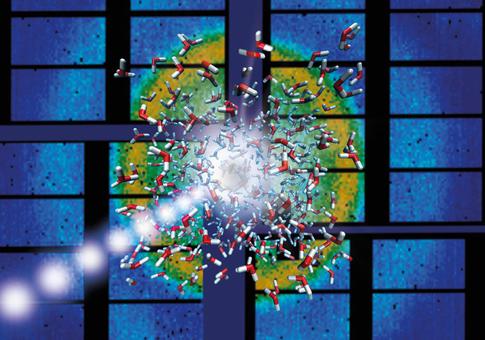XFEL: Surprising behaviour of superheated water
Surprising behaviour of superheated water

The essence of an ideal tool for gaining deeper insights into soft matter physics, biology or nanoscience is accurately capturing changes and movements that occur in a matter of microseconds while maintaining the integrity of the sample. A publication in the Proceedings of the National Academy of Sciences (PNAS) now shows that European XFEL gives unique results for such studies. It can not only capture the microsecond-quick changes but can also be used to investigate heat-sensitive and delicate samples. Researchers used a method called X-ray photon correlation spectroscopy to demonstrate these capabilities on a sample of silica nanospheres dispersed in water.
“Our model sample, water, has been so well studied that we know exactly how it is expected to behave under given experimental conditions,” says Marcin Sikorski, European XFEL scientist and one of the authors of the paper. “We shot the X-rays on the sample and we kept adjusting the intensity of the X-rays, that is, we slowly dialed-up the amount of photons per pulse hitting the sample. When the photons hit the water sample, it absorbed the energy and heated up as expected,” explains Sikorski.
The research team was able to heat the water up to 172 degrees Celsius within a ten thousandth of a second without it evaporating. Remarkably, water stayed in its liquid state even at temperatures way over its boiling point of 100 degrees Celsius. Detailed understanding of this so-called superheated water is essential for a large number of investigations on heat-sensitive samples, such as polymers or biological samples.
“But that is not the only anomalous feature,” says lead author Felix Lehmkühler from DESY. The scientists investigated the movement of silicon nanospheres floating in the water as markers for the dynamics in the sample. “In the extremely overheated water, we observed that the movement of silicon dioxide nanospheres deviated significantly from the expected random Brownian molecular movement. This indicates an uneven heating of the sample.” Existing theoretical models cannot yet satisfactorily explain this behaviour because they are not designed for water under these extreme conditions.
The setup not only allowed the superheated water to be generated but also enabled the scientists to carry out a precisely controlled series of experiments with X-ray flashes of reduced intensity. “Using silicon filters, we fine-tuned the energy of the pulses so that we were able to control exactly how much the water was heated,” reports Lehmkühler. “For example, we were able to determine how strong the X-ray flashes should be so that the temperature of an aqueous sample remains more or less constant.”
Further Information:
DESY Press Release: Liquid water at 170 degrees Celsius
